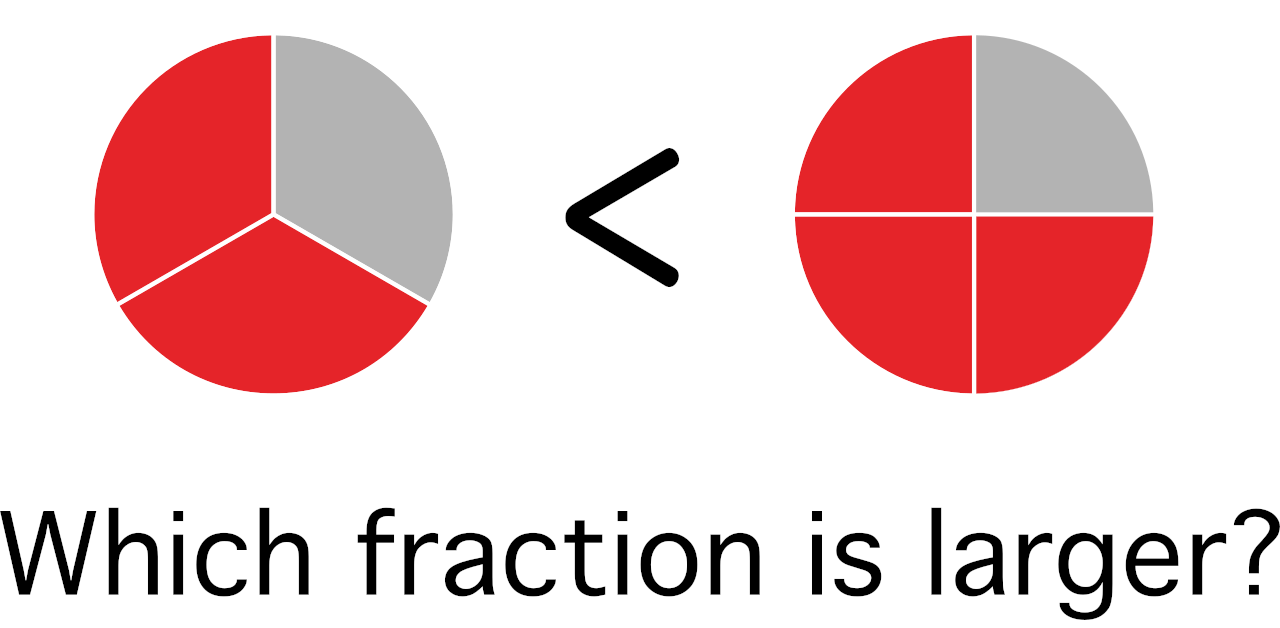Comparing Fractions Calculator
Compare fractions, decimals, and percentages to find which is greater than, less than, or if they are equal.
Solution:
Steps to Compare Fractions and Numbers
Step One: convert all numbers to decimal
12 / 3 = 1.6666666666667
1.75 = 1.75
Step Two: compare the decimal values
1.6666666666667 < 1.75Step Three: rewrite the numbers using the original values
12 / 3 < 1.75On this page:
- Calculator
- How to Compare Fractions
- Method One: Compare Fractions by Converting to Decimal First
- Method Two: Compare Fractions By Finding the Common Denominator
- Method Three: Compare Fractions With the Same Numerator
- Method Four: Cross Multiplication
- How to Compare Fractions to Decimals and Percentages
- Frequently Asked Questions
How to Compare Fractions
Comparing fractions might seem challenging; it seems a bit like comparing apples and oranges. Fortunately, there are a few methods for comparing one fraction to another.

Method One: Compare Fractions by Converting to Decimal First
The first way to compare fractions is to convert them to a decimal value. Divide the numerator of each fraction by the denominator, then compare the decimal values.
You can also convert the fraction into a fraction with a denominator of 100. This will make it easier to divide the numerator by the denominator.
Here’s a tip: use our fraction to decimal calculator to get the decimal value for your fraction. You might also want to check out our decimal equivalents chart to see the decimal equivalents for common fractions.
Method Two: Compare Fractions By Finding the Common Denominator
Another way to compare fractions is to rewrite all the fractions to equivalent fractions with the same denominator. To do this, find the greatest common denominator, then make the denominators of each fraction equal.
Start by finding the lowest common denominator, which we sometimes refer to as the least common denominator. This is the smallest number that each denominator divides equally into. If you’re not sure how to do this, our lowest common denominator calculator will help you find it.
For example, let’s find the lowest common denominator of 6 and 9.
6 × 3 = 18
9 × 2 = 18
LCD = 18
Next, convert each fraction to an equivalent fraction with the common denominator. To do this, multiply both the numerator and denominator of each fraction by the same number so that they have the same denominator.
For example, convert 1 / 6 to a fraction with a denominator of 18.
18 ÷ 6 = 3
3 × 1 = 3
1 / 6 = 3 / 18
You’ll want to repeat this step for each fraction until they all have the same denominator.
You can also use an equivalent fractions calculator or our equivalent fraction chart to see equivalents for common fractions, which might help shortcut the conversion.
Finally, compare the numerators to find which fraction is the largest or smallest. The fraction with the larger numerator is the larger number.
For example, compare 3 / 18 to 2 / 18 to see which is largest.
numerator #1 = 3
numerator #2 = 2
3 > 2
Thus, 3 / 18 is greater than 2 / 18
Method Three: Compare Fractions With the Same Numerator
When fractions have the same numerator, compare them by comparing the denominators. When the numerators are the same, the fraction with the smaller denominator is larger.
Saying this a different way, the larger the denominator, the smaller the number is.
For example, to compare ⅖ and 2/7:
- The numerators of both fractions are the same.
- The denominator of the first fraction is 5, while the denominator of the second fraction is 7.
- 5 < 7, so we know that 2/5 is larger than 2/7.
Method Four: Cross Multiplication
To compare fractions using cross multiplication, you can start by writing the two fractions side by side and then multiplying the numerator of the first fraction by the denominator of the second fraction.
For example, let’s compare 2/7 and 3/5.
2 × 5 = 10
2/7 is equivalent to 10/35
Then, multiply the numerator of the second fraction by the denominator of the first fraction.
3 × 7 = 21
3/5 is equivalent to 21/35
Compare the two products. The fraction with the larger product is the bigger fraction!
Since 21 is larger than 10, we know that 3/5 is larger than 2/7.
In addition to these methods, our fraction calculator also makes it easy to compare fractions.
How to Compare Fractions to Decimals and Percentages
To compare a fraction to a decimal or percent, convert the fraction to either a decimal or percentage and then compare the values.
To convert a fraction to a decimal, divide the numerator by the denominator.
To convert a fraction to a percentage, first convert the fraction to a decimal, and then multiply the decimal by 100.
You can also convert both the fraction and percent into a decimal and compare both values as decimals. To convert a percent into a decimal, simply divide the percent value by 100.
Comparing numbers, fractions, and percentages is also an essential step in sorting a set of numbers from least to greatest.
Frequently Asked Questions
Why do we compare fractions?
We may compare fractions for multiple reasons:
- To determine which fraction is larger or smaller to compare quantities or measurements.
- To simplify fractions and identify common factors.
- To add or subtract fractions.
- To convert fractions to decimals or percentages.
Why is it easier to compare decimals instead of fractions?
Comparing decimals is easier than comparing fractions because decimals are based on the base-10 numbering system, which provides a more precise representation of the number’s size.
You can easily compare decimals by looking at their values to the right of the decimal point, while comparing fractions involves finding common denominators and additional calculations.
How do you compare fractions with whole numbers?
To compare a fraction to a whole number, convert the whole number to a fraction with the same denominator as the fraction you want to compare it to.
You can also convert the fraction to a decimal and compare the whole number to the value.
How do you compare more than two fractions at a time?
You can compare more than two fractions at a time using multiple methods, including:
- Find a common denominator: Convert the fractions so that they share a common denominator, and then compare the numerators. The fraction with the largest numerator is the largest fraction.
- Use cross-multiplication: Multiply the numerator of the first fraction by the denominator of the second fraction and compare it with the numerator of the second fraction multiplied by the denominator of the first fraction. Repeat this process for all pairs of fractions. The fraction with the largest product is the largest fraction.
- Order the fractions: Order the fractions from smallest to largest and then compare the first and last fractions.


